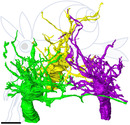Ph.D. Thesis
Retinal connectomics of the anchovy retina
The retina of the vertebrates is a prime example for investigations of the structure-function-relationship of complex sense organs, as well as their specific adaptations to varying environmental conditions and orientational requirements. The histology and fine structure of the outer retina (photoreceptors and pigment epithelium) give some hints towards visual acuity (photoreceptor density), sensitivity (e.g. tapeta) and contrast mechanisms (morphotypes of photoreceptors). These can be specified further by cell number ratios and neuroanatomical indications of the inner retina. The aim of this project is to achieve a basic understanding of the composition and function of this nerve network, just as well as to get insights into the specialization of the visual system of the anchovy (Engraulis encrasicolus).
The anchovy has a one of a kind retinal fine structure. It renders these fish as specialists for the perception of polarized light as means of contrast formation. This novel sense perception among vertebrates has been physiologically verified. It is made possible by a peculiar fine structure of the photoreceptors – the polycones. The underlying framework of secondary retinal nerve cells was – until recently – completely unknown. Precedent research in our workgroup has allowed insights in this system along with first cell classifications based on 3D models.
This new knowledge in the area of research of retinal connectomics is based on the latest developments on the field of serial block face scanning electron microscopy (SBFSEM). The milling can be done with mechanical cutting with a diamond knife (Heidelberger Hobel) or with an ion beam (FIB-FESEM). This for the first time allows for almost contortion-free image stacks. These 3D image stacks enable a complete reconstruction of nerve circuits in nanometer resolution as well as morphological and morphometric analysis.
While the FIB-FESEM has an extraordinary resolution (down to 8 nm in all 3 dimensions) and a rather small acquisition field the Heidelberger Hobel allows a much larger acquisition area but has considerably lower resolution (minimum 40 nm along the Z axis). To be able to trace and label the finely ramified entanglements of the cells in the outer nuclear layer as well as the largely outstretched dendritic fields of the secondary neurons both SBFSEM techniques are applied on particularly prepared samples.
All nerve cells that can be found in the combined volume of the two associated image stacks are being labeled manually with the 3D reconstruction program Amira ®. Afterwards they are computed into 3D models that can be rotated and scaled freely. They form the basis for the compilation of a circuitry model for the inner retina. Furthermore the individual secondary neuron types can be described in detail. More importantly it can be shown for all cells (that do not exceed the acquisition area) what synaptic contacts each cell has to other cells, be it cones, rods or other secondary neurons. This is a major improvement in comparison to the traditional staining (Golgi, HRP, immuno staining) to acquire knowledge about cell morphology where only few cell types can be labeled in the same sample.






